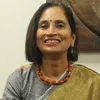How this ‘intrapreneur’ is spearheading a reverse-innovation trend in the Indian fintech market
After joining Bahwan CyberTek (BCT) and BCT Digital as an intrapreneur and President, Jaya Vaidhyanathan was responsible for launching their financial initiatives. She is passionate about reverse innovation, products specific, and unique to the Indian market with a global reach.
As President of Bahwan CyberTek (BCT), a global technology company specialising in IoT and predictive analytics, and CEO of BCT Digital, Jaya Vaidhyanathan is both an engineering professional and an innovator.
She joined as an ‘intrapreneur’ and in the capacity of a president, kick-started their fintech initiatives. At BCT, Jaya started the fintech’s risk management product portfolio, today known as rt360.
She also spearheaded “reverse innovation” - products made in India would have a global reach, instead of the reverse that had been prevalent in global markets for the past decades.

Jaya started her career as an investment banker in New York after obtaining her computer engineering degree from Madras University, a management degree from Cornell University, and earning a CFA charter. She specialised in mergers and acquisitions across technology, telecom, and utilities verticals with several top Wall Street firms.
Jaya is one among a small crop of women leaders in the banking sector in India, and brings over two decade of experience of spearheading functions like financial services, M&A, risk management, outsourcing advisory & technology across leading companies like Accenture and Standard Chartered Bank. In her personal space, Jaya is a fitness enthusiast and is an avid runner. She has regularly participated in marathons.
In a chat with HerStory, Jaya Vaidhyanathan speaks about her 20-year career, innovations in the fintech space, and reverse innovation.
HerStory: Can you trace your career journey from when you began until now?
Jaya Vaidhyanathan: My expertise lies in merging the technology and financial services spectrum. I have been leading and mentoring organisations and their end-to-end operations, including product creation, successful scaling, digital transformation, mergers and acquisitions, and restructuring. I have been responsible for the business transformations of several Fortune 100 clients, managing large teams, and transforming greenfield businesses into large corporates.
I served on the boards of Mahindra Sanyo and Digispice.
While I started my career with Wall Street as an investment banker specialising in mergers and acquisitions, my calling came when I recognised a need to bring value-based IT jobs to India. This remains my passion even today. I joined HCL, where I facilitated several multi-million-dollar deals that opened thousands of job opportunities for Indian engineers. This focus continued in my later roles as well – first as a Managing Partner at Accenture, and later as the Executive Vice President of Standard Chartered Bank.
In 2014, I joined Bahwan CyberTek as an ‘intrapreneur’ to build and promote their fintech initiatives. I am currently the CEO of BCT Digital, driving product innovation targeting India’s financial services industry.
HS: As a CEO of BCT Digital, what are your core responsibilities?
JV: As the CEO, I manage the end-to-end business operations, expansion plans, P&L, and go-to-market strategy. As an “intrapreneur” at BCT Digital, I am responsible for product innovation and ensuring market success.
I build products targeting critical areas that impact the financial services industry. The success of product innovation lies in identifying white spaces and building products that are specific to India, yet scalable to the global markets.
HS: With fintech emerging as a huge market, how are you differentiating from the other players in the market?
JV: We look at the fintech space from a “business-first, technology-agnostic” viewpoint. We leverage disruptive technologies, such as AI and predictive analytics, to solve a yet-unsolved business problem.
We’re a niche player in the regtech arena. We concentrate on ideation and problem solving for the white spaces or adjacencies that are often overlooked by top players. At present, we are focused on the credit and operations risk management vertical. As an example – we built out a successful product, combining AI, blockchain, and machine learning to identify stressed accounts early on and improve recovery and profitability. The products are running in top banks in India, the Middle East, and the US.
We ideate on new regulations and risk management principles and are often in the market way before our nearest competitor.
HS: What are your offerings in the fintech sector?
JV: We drive digital transformation for banks and financial institutions through our risk management product suite rt360. The product suite enables financial institutions to optimise the management of their risk and regulatory compliance needs, empowering them to focus on credit growth and profitability.
rt360 offers a comprehensive suite of risk management & regulatory compliance solutions for the banking industry, spanning across credit risk, liquidity risk, model risk, and operational risk. Our products include an early warning system to identify incipient stress in large loan portfolios; model risk management to calibrate models in line with IFRS9 requirements, IND-IAS, CECL, and DFAST; asset-liability risk management for NBFCs; and a mobility-rendered RAROC pricing model.
HS: Can you tell us about reverse innovation?
JV: Reverse innovation and Make in India are two concepts that work well together.
Our banking economy has its share of challenges. A rising number of NPAs is a foremost threat to our banking system. There are other issues as well, but the biggest is that of financial inclusion – the majority of India’s population is unbanked! To tackle such challenges, we need to innovate specifically and uniquely to the Indian market.
For instance, one of our most successful products was conceptualised with the intention of tackling India’s rising NPA issue. It essentially taps elements of traditional data and big data and interlinks them with a layer of artificial intelligence to unlock hidden patterns. At its core, this is an Indian product – made in India and for India. But due to its effectiveness, it has today found its way to the global market, with numerous clients expressing interest.
HS: In 20 years of building businesses from ground up, can you tell us about your successes and challenges?
JV: My highest highs are when my efforts have resulted in a fundamental change in the economy or society. My lowest lows, I would say, are when deals that I’ve worked on diligently do not fructify. This may be due to regulatory issues or a technicality – but a loss is still a loss.
To take a leaf from my own experience: when I was working with a tech major, a critical deal I was working on fell through, just days away from closure. And all of the hard work we had put in was set back by a whole year simply due to an untimely acquisition that got in the way. For both me and the team, it was certainly the lowest point in our careers.
Just a year later, we were back in the game. The same deal went through, and it was twice as big as what it was to start with. At $780 million – it was the largest of its time! For me the biggest takeaway was the social impact – the deal created jobs for over 6,000 engineers in India. At a particularly tough time (Y2K), it was silver lining.
HS: Tell us more about the CSR initiatives you are part of?
JV: I work with several NGOs, where I apply my expertise in fundraising, optimal financial disbursements, social governance and so on, to bridge any gaps that require professional assistance. I serve on the board of Mastermind Foundation, an NGO that focuses on mental healthcare for women.
I have also participated in DIWWAAS, an organisation that hopes to change the way healthcare is understood and served in rural India. One of their initiatives, ‘Sahodharis’, in which I partook, was lauded by the Public Health Foundation of India.
I am deeply involved in promoting the social and economic well-being of women. Just last year, through various charitable activities, we established around 100,000 touch-points with underprivileged women in India.
HS: Do you think women in technology especially in senior positions are a rare breed? What more can be done to attract women to tech and STEM careers?
JV: Women in senior technical positions are quite rare. But it’s rewarding to know that the numbers are on the rise. Career counselling and corporate mentoring at the high school level must be done to attract girls into STEM careers. While we see more women entering the STEM fields, they are dropping off the corporate ladder midway at an alarming rate. The focus, therefore, needs to be on retention avenues.
Administrative intervention at the right time matters more than we think. It could be as simple as investing in a day care or crèche at work premises. When the dropout paradigm rears its head, recognise the hints at an early stage, counsel them, and show them that you care about their contribution. With the millennials in the workforce, the traditional understanding of what is needed by the workforce must also evolve.
There are three perspectives that we need to recognise here. One, it is important to celebrate female role models who have done it all. Two, equally important is it for senior women in the industry to serve as mentors to young women professionals. And three, companies need to bring in more women at the board level. Beyond bringing a fresh outlook to the table, the latter move gives young women the opportunity of looking up to role models and experiencing their growth first hand.
HS: What are you doing to support women in terms of mentorship and training?
JV: I hold periodic counselling sessions for women at their workplaces. It is important for organisations to understand the challenges of work-life balance and changing generational needs. At the end of the day, the strength to carry on stems from doing something you’re passionate about; something that makes you happy. I advise them to prioritise and stay focused. I advise women to take an hour out of their busy schedules just for themselves; for their emotional and physical health. The world looks brighter after that.
HS: Who or what inspires you?
JV: I strongly believe that you should never put the burden of inspiration on one single person. I draw inspiration from different people around me. For instance, I look up to success stories like Indra Nooyi or Sundar Pichai, because they inspire me to aim higher.
Meanwhile, the person who brings me my tea is a single mother who has raised two kids on her own – with so little money to spare, daily sustenance aside. I draw inspiration from her too.
And it’s not just someone whom you look up to in terms of age. My son inspires me every day. He motivates me to be more than just a good career professional; to be a good human being. I constantly draw inspiration from his passion and dedication towards work.
(Edited by Evelyn Ratnakumar)









